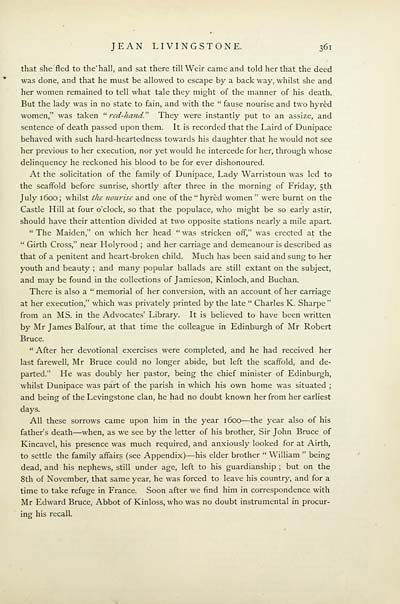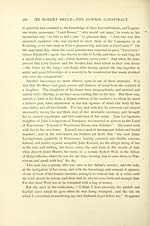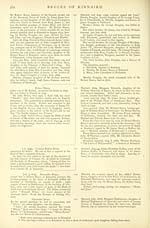Family records of the Bruces and the Cumyns
(379) Page 361
Download files
Complete book:
Individual page:
Thumbnail gallery: Grid view | List view

JEAN LIVINGSTONE. 361
that she fled to the' hall, and sat there till Weir came and told her that the deed
was done, and that he must be allowed to escape by a back way, whilst she and
her women remained to tell what tale they might of the manner of his death.
But the lady was in no state to fain, and with the " fause nourise and two hyred
women," was taken "red-hand." They were instantly put to an assize, and
sentence of death passed upon them. It is recorded that the Laird of Dunipace
behaved with such hard-heartedness towards his daughter that he would not see
her previous to her execution, nor yet would he intercede for her, through whose
delinquency he reckoned his blood to be for ever dishonoured.
At the solicitation of the family of Dunipace, Lady Warristoun was led to
the scaffold before sunrise, shortly after three in the morning of Friday, 5th
July 1600 ; whilst the nourise and one of the " hyred women " were burnt on the
Castle Hill at four o'clock, so that the populace, who might be so early astir,
should have their attention divided at two opposite stations nearly a mile apart.
" The Maiden," on which her head " was stricken off," was erected at the
" Girth Cross," near Holyrood ; and her carriage and demeanour is described as
that of a penitent and heart-broken child. Much has been said and sung to her
youth and beauty ; and many popular ballads are still extant on the subject,
and may be found in the collections of Jamieson, Kinloch, and Buchan.
There is also a " memorial of her conversion, with an account of her carriage
at her execution," which was privately printed by the late " Charles K. Sharpe "
from an MS. in the Advocates' Library. It is believed to have been written
by Mr James Balfour, at that time the colleague in Edinburgh of Mr Robert
Bruce.
" After her devotional exercises were completed, and he had received her
last farewell, Mr Bruce could no longer abide, but left the scaffold, and de-
parted." He was doubly her pastor, being the chief minister of Edinburgh,
whilst Dunipace was part of the parish in which his own home was situated ;
and being of the Levingstone clan, he had no doubt known her from her earliest
days.
All these sorrows came upon him in the year 1600 — the year also of his
father's death — when, as we see by the letter of his brother, Sir John Bruce of
Kincavel, his presence was much required, and anxiously looked for at Airth,
to settle the family affairs (see Appendix) — his elder brother " William " being
dead, and his nephews, still under age, left to his guardianship ; but on the
8th of November, that same year, he was forced to leave his country, and for a
time to take refuge in France. Soon after we find him in correspondence with
Mr Edward Bruce, Abbot of Kinloss, who was no doubt instrumental in procur-
ing his recall.
that she fled to the' hall, and sat there till Weir came and told her that the deed
was done, and that he must be allowed to escape by a back way, whilst she and
her women remained to tell what tale they might of the manner of his death.
But the lady was in no state to fain, and with the " fause nourise and two hyred
women," was taken "red-hand." They were instantly put to an assize, and
sentence of death passed upon them. It is recorded that the Laird of Dunipace
behaved with such hard-heartedness towards his daughter that he would not see
her previous to her execution, nor yet would he intercede for her, through whose
delinquency he reckoned his blood to be for ever dishonoured.
At the solicitation of the family of Dunipace, Lady Warristoun was led to
the scaffold before sunrise, shortly after three in the morning of Friday, 5th
July 1600 ; whilst the nourise and one of the " hyred women " were burnt on the
Castle Hill at four o'clock, so that the populace, who might be so early astir,
should have their attention divided at two opposite stations nearly a mile apart.
" The Maiden," on which her head " was stricken off," was erected at the
" Girth Cross," near Holyrood ; and her carriage and demeanour is described as
that of a penitent and heart-broken child. Much has been said and sung to her
youth and beauty ; and many popular ballads are still extant on the subject,
and may be found in the collections of Jamieson, Kinloch, and Buchan.
There is also a " memorial of her conversion, with an account of her carriage
at her execution," which was privately printed by the late " Charles K. Sharpe "
from an MS. in the Advocates' Library. It is believed to have been written
by Mr James Balfour, at that time the colleague in Edinburgh of Mr Robert
Bruce.
" After her devotional exercises were completed, and he had received her
last farewell, Mr Bruce could no longer abide, but left the scaffold, and de-
parted." He was doubly her pastor, being the chief minister of Edinburgh,
whilst Dunipace was part of the parish in which his own home was situated ;
and being of the Levingstone clan, he had no doubt known her from her earliest
days.
All these sorrows came upon him in the year 1600 — the year also of his
father's death — when, as we see by the letter of his brother, Sir John Bruce of
Kincavel, his presence was much required, and anxiously looked for at Airth,
to settle the family affairs (see Appendix) — his elder brother " William " being
dead, and his nephews, still under age, left to his guardianship ; but on the
8th of November, that same year, he was forced to leave his country, and for a
time to take refuge in France. Soon after we find him in correspondence with
Mr Edward Bruce, Abbot of Kinloss, who was no doubt instrumental in procur-
ing his recall.
Set display mode to:
![]() Universal Viewer |
Universal Viewer | ![]() Mirador |
Large image | Transcription
Mirador |
Large image | Transcription
Images and transcriptions on this page, including medium image downloads, may be used under the Creative Commons Attribution 4.0 International Licence unless otherwise stated. ![]()
| Histories of Scottish families > Family records of the Bruces and the Cumyns > (379) Page 361 |
|---|
| Permanent URL | https://digital.nls.uk/95075534 |
|---|
| Description | A selection of almost 400 printed items relating to the history of Scottish families, mostly dating from the 19th and early 20th centuries. Includes memoirs, genealogies and clan histories, with a few produced by emigrant families. The earliest family history goes back to AD 916. |
|---|

